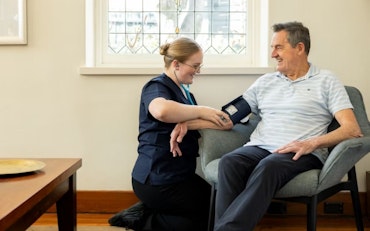How to ensure safety, stability and support in epilepsy care
In this article, we will discuss some safety measures and support approaches that can be followed to help epileptic patients live conveniently at home. We will also discuss how you can create a supportive environment for them and make them enjoy independence safely within the home.
![<p>Epilepsy can be troubling for carers and those experiencing it, along with a concerning factor for many in day-to-day life.[Source: FG Trade via iStock]</p>](https://agedcareguide-assets.imgix.net/news/articles/wp/FG-Tradedis__0905.jpg?fm=pjpg&format=auto&w=550&q=65)
Epilepsy can be troubling for carers and those experiencing it, along with a concerning factor for many in day-to-day life.[Source: FG Trade via iStock]
SPONSORED — Being diagnosed with an illness like epilepsy is enough to change one’s life overnight. Not knowing exactly when the seizures might come is enough to create fear and anxiety. You suddenly need to start adjusting to your environment and always keep your medications in mind. All these can indeed be overwhelming.
Have you been diagnosed with epilepsy and are worried, feeling uncertain or anxious about how to go about caring and managing this condition? Perhaps you have someone with this condition you care for… Know that you are not alone. Many families provide home-based care for their loved ones going through this challenge every day. There is no doubt that living with epilepsy comes with a number of challenges, but when equipped with proper knowledge and support, you can create a safe and comfortable environment for yourself or a loved one.
Epilepsy and the importance of home-based care
Before diving into how you can manage epilepsy at home, you need to first understand what epilepsy is. You also need to know how it affects the daily life of those living with it, so you can know the kind of support you will render.
Epilepsy, in simple terms, is a condition that makes people have seizures repeatedly. The seizures usually happen due to some strange activities occurring in the brain. They come in different forms; some last a few seconds, while others last longer than that. They can also affect movement, feelings and awareness of the affected person.
Types of seizures
The type of seizure someone has usually determines the type of care they will receive.
1. Focal seizure
A focal or ‘partial’ seizure affects only a specific part of the brain. It usually causes symptoms like twitching, strange feelings or a change in one’s level of consciousness. Its symptoms usually occur in a particular part of the body.
2. Generalised seizure
A generalised seizure affects both sides of the brain. It is characterised by loss of consciousness, muscle stiffening and other movements on both sides of the body. It includes several subtypes:
- absence seizures;
- tonic-clonic seizures;
- myoclonic seizures; and
- atonic seizures.
A proper understanding of the type of seizures someone is going through will help determine the appropriate safety measures to implement at home. Not only that, it will also help avoid triggers that could lead to seizures and know the specific care protocols to implement at home.
Why is home care important for epilepsy care?
In diagnosing epilepsy and offering emergency intervention, hospitals and clinics are the key players. However, what happens when the patient gets discharged and has to return home? Do the patients stop caring for themselves and limit their care to the support they’ve received in the hospital?
They can continue to manage their condition and continue with their care at home.
- Most cases of epileptic seizures occur in homes and outside of medical facilities.
- Their comfort at home, reduced stress and familiarity with the environment can also help them in controlling their seizures.
- They can easily manage their daily routines and ensure consistent care in their homes.
When patients or caregivers properly observe home care, it can greatly help to reduce the risk of seizures. It can also make their quality of life better and help them manage their daily activities on their own.
How to create a safe environment at home for epilepsy care
When planning home care for someone with epilepsy, safety should be your top priority. You must make sure that every key part of the house is adjusted and modified so that whenever a seizure occurs, the patient will be safe during their seizure and after the seizure has lapsed. House modifications will help to prevent injuries from occurring and will also help the mind be at ease.
Before going into how you can make the home safe for people dealing with epilepsy, especially in some specific parts of the house, you first need to make sure dangerous items are not scattered around the house. Doing this will greatly help to reduce injuries and damages during seizure episodes.
Ensuring safety in the living room
In most cases, the living room is where the majority of people spend their time. For an epileptic patient, this isn’t different. As a result, more seizures should be expected in the living room than any other part of the house.
It is, however, necessary to make sure that whenever a seizure occurs in the living room, preventive measures should have already been in place. This will not only prevent unforeseen accidents, but it will also give both the patient and caregivers peace of mind.
In general, you can follow these tips to ensure a safe haven for yourself or a loved one:
1. Pad corners on furniture and countertops
Those sharp edges in your table, shelves, counters, etc, can cause grave injuries during a fall or seizure. You can use foam to cover the edges of your furniture and other things that could affect them; protective padding can lower the risks of cuts, bruises or head injuries.
2. Place carpets or other forms of cushioning on the floor to minimise impact from falls
Severe injuries can occur from seizures if you have hard flooring, like tiles or wooden floors. Installing wall-to-wall carpet or cushioned mats on the floor in areas that you or your loved one usually occupies can be greatly helpful. Making the floor soft will provide a softer landing surface in case of a seizure.
3. Use secured rugs to prevent slipping
Another way to make the living room safe is by making use of secured rugs. Secured rugs are used to prevent slipping by helping footwear and feet grip the surface. Materials like rug pads or rug grippers have double-sided tape that can be used to seal them firmly in place.
4. Avoid sharp or glass home decor items
Glass vases, mirrors and other fragile home decor items may look nice. However, when you have an epileptic patient inside the house, these items can become really dangerous, especially when knocked over during a seizure. You can replace these fragile items with soft, shatterproof or plastic alternatives to reduce the risk of potential harm.
Safety in the bedroom and during sleep
Seizures can happen at any time, so it is necessary to take precautions.
1. Use low beds or floor beds
Seizures can happen at any time, unexpectedly; when they happen, the individual may fall out of bed. When this occurs, they may hit their head against an object or even the floor. Severe injuries can be prevented by placing a mattress or foam on the floor to cushion falls, along with reducing the height they may fall from the bed itself. Doing these will no doubt minimise the risk of sustaining injuries when seizures occur during sleep.
2. Add paddings to bed rails if needed
Adding padding to bed rails can help prevent rolling out of the bed and sustaining injuries. The padded rails will also protect the person from hitting hard surfaces. However, you should ensure that the rails are fitted properly and checked regularly to make sure they don’t become a problem themselves.
3. Avoid heavy blankets
Unless it is recommended by a specialist, heavy blankets should be avoided when sleeping. It may be true that heavy blankets can help people sleep peacefully and comfortably, however, they can also limit or even restrict movements during a seizure.
Kitchen and cooking safety precautions
People with epilepsy should not cook or use kitchen appliances without supervision or an action plan. Cooking involves risks, such as sharp utensils, flames and hot substances, that can be dangerous if not handled carefully.
1. Use microwaves or appliances with automatic shut-off features
Microwaves are a perfect alternative to the common stove tops, whether gas cookers or electric cookers. They are almost the best alternative as they pose the least risk, especially for those prone to seizures. This is because microwaves are always enclosed and easy to use — they don’t involve exposed heat. Appliances such as electric cookers, toasters, rice cookers and other appliances with an automatic shut-off feature are also good recommendations for epileptic patients as they do not cause overheating, fire or burns when a seizure occurs.
2. Avoid open flames or stove tops without supervision
Open flames from gas burners or even too much exposure to electric cookers can cause major hazards if seizures occur while cooking. It is advisable to only use them when someone is present to help in case there is an emergency.
3. Store knives and sharp tools in locked drawers
Sharp kitchen utensils, like knives and scissors, should be kept out of easy reach and stored in a secure space to prevent accidental cuts or injuries. Locking the drawers or fixing childproof latches can provide added safety.
4. Use seated stations for food preparation
Preparing food while seated reduces the risk of falls and can also make it easy to maintain stability while cooking or doing other tasks in the kitchen. Using a stool or chair at the counter or table offers greater control and comfort.
General home safety principles for epilepsy care
Apart from the room-specific modifications that can be done to ensure safety, there are general principles that should be applied throughout the home to ensure overall safety.
1. Fixing corner protectors on furniture with sharp edges
Furniture items, such as tables, desks, and countertops, have hard, pointed corners that can cause grave injuries if someone falls against them. However, covering them with foams or rubbers can help lessen the impact of falls on them and lower the risk of cuts and injuries that may occur.
2. Proper lighting in hallways, bathrooms and stairwells
Fix proper lighting throughout the home, especially where people usually pass through or in transitional areas. This will help prevent missteps and falls.
3. Avoid glass tables or display cases as much as possible
If a seizure occurs and causes one to fall on glass surfaces, they can shatter and pose a major hazard. However, replacing glass furniture with wooden or plastic furniture can prevent severe cuts and injuries in case of accidents.
4. Clear items that can lead to injuries
Items like shoes, toys, cords and bags can cause falls and lead to injuries when left on the floor and stairways. Removing them can reduce the chances of tripping or falling during seizures.
Other general preventive measures that could be implemented in the home include:
- covering radiators and heaters to prevent burns;
- keeping pathways clear throughout the home for safer movement;
- making use of soft flooring; and
- fixing furniture properly to the walls to prevent harm.
How to promote stability in epilepsy care
In epilepsy care, being consistent in one’s care routine and medication management is very important. Some seizures are usually triggered when medications are missed; some come as a result of poor sleep or high stress levels. It is, however, necessary to create and maintain a structured daily routine to maintain both physical and mental stability.
1. Adhering to medication
The most effective way to manage seizures and also reduce how frequently they occur is to stick to the prescribed medication. It is, however, possible to miss out on drugs, so using pill organisers can help you stay on track. Alarms and medication journals can help prevent forgetting your medications. Medication journals help track what medication has been taken, note any side effects and monitor how well the medication is working. Medications should be stored in a safe, dry place and should be out of reach of children and pets.
2. Adequate sleep and rest
Poor sleep quality can also trigger seizures. When you sleep very little or are unable to have a deep sleep, it can lead to restlessness and, as a result, trigger seizures. You should limit your screen time when your time to sleep is close. You should also limit the noise around you, as it can interfere with your sleep and make falling asleep difficult.
3. Stress reduction
Another common trigger that can worsen symptoms of epilepsy is stress. Stress worsens symptoms by disrupting brain activities and interrupting sleep patterns. It can even lead to anxiety and depression. Simple relaxation techniques, like breathing exercises or gentle yoga, can calm your nervous system down and improve your emotional balance.
How to build support for epilepsy care
Living with epilepsy goes beyond just taking drugs to manage the condition. It has to do with managing the patient’s emotions and giving them a sense of purpose, reminding them they still have hope to live a normal life. Their dignity, independence and connection with their environment and the rest of the world needs to be taken into consideration.
1. Help them feel more independent
Always needing help to do normal day-to-day tasks is usually frustrating. This is why finding ways to encourage independence can boost confidence in people with epilepsy and others going through one health challenge or another. As a care provider, involve them in making decisions about their day, meals or routines. Do not just do everything for them.
You can also make use of some amazing tools out there, such as reminder apps, voice assistants and smart home appliances. These can help them with some tasks without needing help or constant supervision. You can even encourage them to take part in hobbies, join classes or even try volunteering programs.
2. Help them build social connections
Epilepsy can sometimes lead to isolation, especially when people around them lack understanding. This is why it is so important to educate people close to them, most especially close families and friends. This takes the fear out of them. Once they know what to do when a seizure happens, they will feel more confident and comfortable supporting the patient.
Another way of keeping them connected is letting them hang out with others. This can be a game night, a class or even online support groups. Being a part of a community can help a lot.
In addition, encourage them to open up about their feelings during rough times. Giving them a listening ear and letting them pour out their mind can sometimes be the best form of support you can render.
3. Support them at school or the workplace
Going to school or showing up at work can be stressful, even without epilepsy. So, when someone now has it, the goal is to make things as smooth and safe for them as possible. You can let their teachers, bosses and colleagues know their condition without sharing every detail about their sickness. Let them know what to do if a seizure occurs and who to contact. They might need more time on school work or they may need to skip a shift after a rough night; helping them discuss their condition can be significant.
Conclusion
Caring for someone with epilepsy extends beyond just helping them manage their seizures, It is about helping them live a supported life of dignity and making them independent. When the home is safe for them and their routine is well-maintained, everything will feel less overwhelming both for the person living with epilepsy and those caring for them.
To find out more about what quality care looks like, visit Support Network and get in touch with the team.










